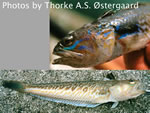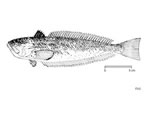|
Trachinus draco
|
![Greater weever from the Belgian part of the North Sea. [Photo © Hans Hillewaert / CC BY-SA-3.0, 2005]](images/marine_life/MVP006181.jpg)
|
|
Class: Actinopterygii (ray-finned fishes)
|
|
Order: Perciformes
|
|
Family: Trachinidae
|
|
Genus: Trachinus
|
|
Species: draco
|
Common Names
Greater weever, Grande vive, Escorpión
|
Region
Eastern Atlantic
|
Countries
Albania, Algeria, Belgium, Bosnia and Herzegovina, Bulgaria, Croatia, Cyprus, Denmark, Egypt, France, Georgia, Germany, Greece, Ireland, Israel, Italy, Lebanon, Libya, Malta, Morocco, Netherlands, Norway, Portugal, Romania, Russia, Slovenia, Spain, Sweden, Syria, Tunisia, Turkey, Ukraine, Mauritania, United Kingdom, Canary Islands ( Spain ), Gibraltar (UK), Isle of Man (UK), Madeira (Portugal), Serbia
|
|
|
|
|
Taxonomy and Biology
|
|
Size: Max length : 53.0 cm TL male/unsexed; common length : 25.0 cm SL male/unsexed; max. published weight: 1,860 g
|
Habitat
Temperate marine dimersal fish. Found on sandy, muddy or gravelly bottoms, from a few meters (in summer) to about 150 m.
|
Habits
Rest on the bottom, often buried with eyes and tip of first dorsal fin exposed. At night they swim around freely, even pelagically.
|
Prey
Feed on small invertebrates and fishes; chiefly nocturnal.
|
|
|
|
Venom
|
Average Venom Qty
One venom apparatus from an average size fish yielded 110mg protein. Chhatwal and Dreyer (1962) (Ref: R009517).
|
General: Neurotoxins
Probably not present
|
General: Myotoxins
Probably not present
|
General: Procoagulants
Probably not present
|
General: Anticoagulants
Probably not present
|
General: Haemorrhagins
Probably not present
|
General: Nephrotoxins
Probably not present
|
General: Cardiotoxins
Probably not present
|
General: Necrotoxins
Secondary necrotoxic activity only
|
General: Other Toxins
Unknown
|
|
|
|
Clinical Effects
|
General: Dangerousness
Moderate envenoming possible but unlikely to prove lethal
|
|
General: Rate of Envenoming: Unknown
|
|
General: Untreated Lethality Rate: Unknown
|
General: Local Effects
Immediately after envenomation the patient develops intense pain at the puncture site, which may be excruciating and difficult to control with analgesics.
|
General: Local Necrosis
Potentially may occur
|
General: General Systemic Effects
The victim may be agitated, pale, or anxious and headaches, nausea, vomiting, sweating, hypotension and respiratory difficulty may occur.
|
General: Neurotoxic Paralysis
Unlikely to occur
|
General: Myotoxicity
Unlikely to occur
|
General: Coagulopathy & Haemorrhages
Unlikely to occur
|
General: Renal Damage
Unlikely to occur
|
General: Cardiotoxicity
Unlikely to occur
|
General: Other
Unknown
|
|
|
|
First Aid
|
|
Description: First aid for Scorpaenidae and Other Selected Fish Stings (stonefish, scorpionfish, catfish, bearded goul, devil fish, butterfly cod, lionfish, zebrafish, bullrout, cobbler, fortescue, waspfish, thetis fish, red velvet fish, weeverfish, surgeonfish, rabbitfish, scats, striped butterfish, jacks, pompanos, toadfish, frogfish, stargazers etc.)
|
Details
1. The victim should immediately leave the water.
2. Any broken spines should be removed using forceps, if available. Do not incise the wound to search for spine fragments.
3. The wound should not be rubbed, or spines crushed as this may worsen the local effects of the sting. Do not apply a pressure bandage, tourniquet or cut or suck the wound.
4. The use of immersion in hot water is controversial. Some authorities suggest that immersing the stung limb in hot water may reduce pain. Others suggest it is useless. It is potentially hazardous, if used incorrectly, as it may cause burn injuries. However, for fish stings causing pain, clinical experience strongly suggests it is beneficial for most patients, when applied correctly. If used, immerse the opposite limb to that stung in water which is hot, but bearable with prolonged contact. It should not be so hot as to cause pain. Then immerse the stung limb as far as necessary to include the sting area. Keep both limbs in the water for 15-20 minutes, providing there is relief of pain. If there is no relief of pain in this time, abandon the immersion. If pain has subsided, it may return on removal from the water, in which case, reimmerse for a further 15-20 minutes. Repeat this process up to 4 times. If after 1-2 hours, the pain is still severe on removal from hot water, then other forms of pain relief may be required, but these will require medical intervention.
5. The wound may be gently cleaned with soapy water.
6. If the patient collapses, standard pre-hospital resuscitation should be used (airways, breathing, circulation), as appropriate.
7. Except in minor stings, with readily controllable pain, seek medical advice at the earliest opportunity. This is especially important for stonefish stings, where an antivenom is available, which may give rapid and dramatic relief of symptoms.
|
|
|
|
Treatment
|
Treatment Summary
The treatment for acute envenomation includes application of heat to the injured site.
|
Key Diagnostic Features
Typically, envenomation by weeverfish occurs when a swimmer or, more often, a fisherman steps on or handles a fish caught in a net. Envenomation causes local symptoms at the site of the sting, such as intense local pain, clear sting puncture mark, burning sensation, redness, and swelling.
|
General Approach to Management
Treat all cases with significant local pain as urgent & assess in an emergency department setting
|
Antivenom Therapy
No antivenom available
|
|
|
|
Images
|

|

|

|

|
|
|
|
Greater weever from the Belgian part of the North Sea. [Photo © Hans Hillewaert / CC BY-SA-3.0, 2005]
|
Trachinus draco (Denmark). [Photo by Thorke A.S. Østergaard / CC BY-NC-SA 3.0, 2001]
|
Trachinus draco ( Greater weever) [Public domain]
|
Trachinus draco. [Schneider, W. FAO species identification sheets for fishery purposes. / CC BY-NC-3.0, 1990]
|
|
|
|
|
|



